This report covers:
- Data mining
- How to measure group size
- Where’s the edge?
- The big question
- It’s always a guess
- The equipment
- Can groups be measured without a caliper?
- A new tool
- Finding the edge
- Accuracy
- The bottom line
- When doctors disagree…
What hope do we have? - Summary
I’m going to discuss measuring group sizes today — how measurements are obtained and the accuracy we can expect — of the group size measurements, not the guns that shot the groups.
Data mining
I have written quite a bit on this subject in the past. I’m not going to rewrite all of that today. Instead I copied what I’ve written and the I edited it to reflect the lessons I have learned since those reports were written. So, yes, this report was easy to write, but it still took a long time because I had to edit as I went.
How to measure group size
The method I’m about to explain is the same one that was used by Harry Pope at the turn of the 20th century. It is simple, fast and easy to do. It’s also open to interpretation and small errors. Are the hairs standing up on the back of your neck, yet?
It’s customary to measure shot groups from the two centers of the bullet holes that are farthest apart. But the new shooter wants to know how to find the center of a hole reliably. The answer is simple — don’t look for the center, find the edge. If you measure from the extreme edges of the two bullet (or pellet) holes farthest apart and subtract one bullet/pellet diameter from the answer, you have just subtracted the radius from each of the two outlying bullet holes. The radius is the distance from the center of a hole to its edge — so in fact you have just found the two centers of the holes in question.
You bracket the group on its largest dimension with a dial caliper, so that one jaw touches the extreme edge of one hole and the other jaw touches the extreme opposite edge of the hole farthest away from the first hole. It sounds easy and would be except for one thing.
Where’s the edge?
To do it this way, you need to find the edge of each hole, and that’s where it gets hard. If you’re shooting wadcutter pellets, the holes will be sharp, round and easy to measure; but if you’re shooting domed or pointed pellets, the holes will be much more vague. This is where those who shoot centerfire rifles have it easy compared to airgunners. Because their bullets go so fast, they leave sharp, round holes in the target regardless of the shape of the bullet.
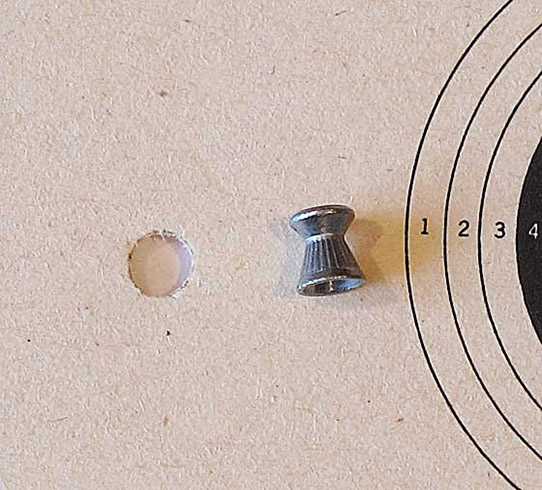
It’s pretty obvious why wadcutters are the darlings of the paper target crowd!
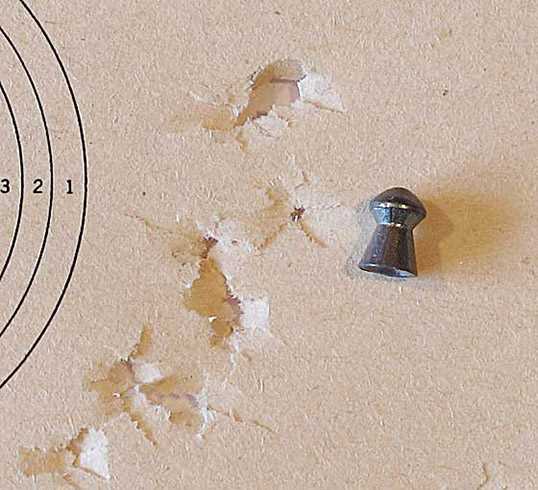
These Beeman Kodiak domed pellets leave vague holes. Measure that group!
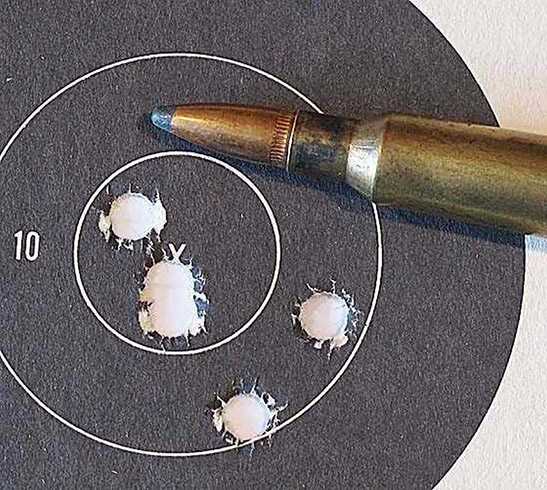
Even pointed bullets tear clean holes when they rip through targets at close to 3,000 f.p.s., like the 87-grain spitzers from this .250/3000 Savage.
BB often “cheats” by using small scissors to cut away the torn paper around pellet holes, so they show up better in a picture. He has to be careful to cut those paper pieces circular so they look like the pellet passed through.
The big question
Here’s the question many of you have asked in the comments to this blog, and many more have wondered privately — how is it possible to identify the exact edge of a pellet hole with a caliper or any other measuring instrument? It’s not.
It is not possible to locate the exact edge of a pellet hole with a measuring instrument — whether it be a dial caliper or the index marks on a ruler. The hole is insubstantial, and you’re trying to measure it as though it was solid. It can’t be done — not with great precision, anyway.
It’s always a guess
Where the edge of the hole really is…is always a guess. Always! But with careful work, you can get the error range down to just a few thousandths of an inch.
The equipment
When I measure groups, I do not look at the caliper dial or the digital readout. I adjust the jaws until they just touch the edges of the two holes I’m measuring. This usually takes several attempts and the stronger the light, the easier it is to be precise. The target paper must be flat to do this right, so the best way is to lay the target on a well-lit table and then place the dial caliper over the group and work the caliper jaws down until they touch just the edges of the holes. If there isn’t enough light on the target, I’ll use a powerful flashlight — a tactical flashlight — to illuminate the target.
Can groups be measured without a caliper?
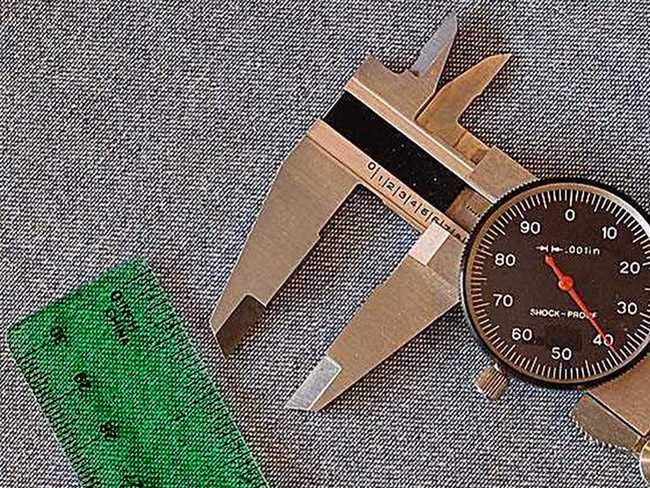
It is possible to measure groups with a ruler, but a caliper does make it easier.
A new tool
Just before Christmas last December, reader David Enoch contacted me about a new tool called the Group Mate that was developed in the United Kingdom. David bought a bunch of them and sent one to me as a gift. Here is what I have found thus far.
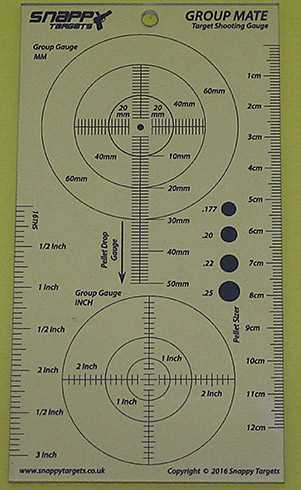
The Group Mate tool from Snappy Targets is for measuring group sizes.
I find this tool works best on light-colored paper because the lines disappear when they are over black bulls. Also the circles are for encompassing the entire group — not for measuring the center-to-center distance. In the inch-pattern circles at the bottom of the tool, the hash marks are graduated in one-eighth inches.
I haven’t used the tool that much yet, but if I wasn’t always shooting at bullseye targets, this might be the way to go.
Finding the edge
Have you noticed that my groups often end up in the white target paper instead of in the black bullseye? My brother-in-law, Bob, used to tell me that he felt the guns I shot were inaccurate because they didn’t hit the black bull. However I sometimes shoot groups in the white so I can find the edge of the pellet holes easier. Bob now shoots groups of his own with firearms and pellet guns every week and he understands what I have been saying.
When you look for the edges of the holes, there are sometimes clues. Sometimes the pellets will leave a round lead ring where they tear through the paper. You can see this on the white target paper but not on the black. Other times there will be rips that extend radially away from the edge of the hole. These rips are part of the diameter of the pellet or bullet, as I will now show you.
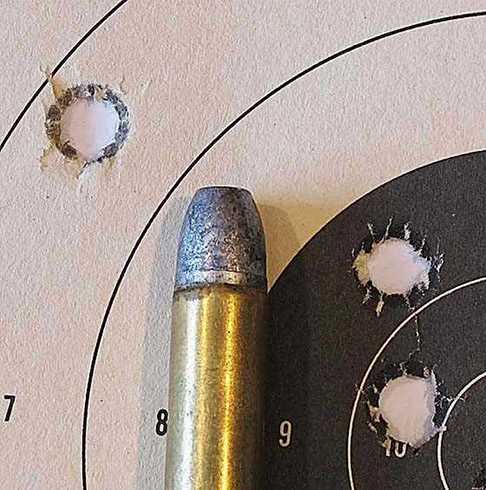
The .45/70 lead bullet leaves a distinct dark ring at its edge when it punches through paper — even at just 1,200 f.p.s.! But that ring can’t be seen in the black bullseye.
Accuracy
I’ve said this many times before, but it bears repeating — any group measured to the thousandth of an inch is off by up to twenty-five thousandth of an inch. I may have even said a larger error number than that.
Why are people’s measurement of groups so inaccurate? Well, do you know what twenty-five thousandths of an inch looks like? For your entertainment I will now illustrate how large that is.
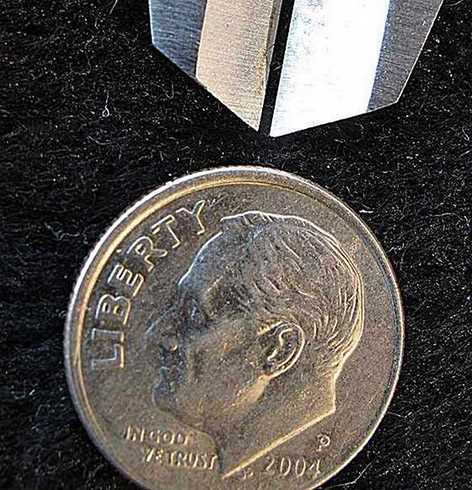
People talk about 25 thousandths of an inch. This is how large it really is.
The bottom line
I resolved not to obsess over this issue years ago. Because if I couldn’t get past it, I couldn’t write about airguns. In the same way that I know that chronograph readings are also not exact, I know that the closest I can come to an exact measurement on paper is probably 0.005-inches, when everything goes my way. But give me ragged BB holes to measure and a paper target that rips instead of showing clean holes, and the error is probably closer to 0.020 inches. And that’s on a good day, when I am really trying my hardest. But the number I publish will always have two or three decimal places, and it will look official to everyone.
Yes there are tricks like putting tape on the backside of the target to limit the paper from tearing, using stiff cardboard the same way, and sometimes these techniques do work well, but other times they don’t. I use cardboard all the time.
When doctors disagree…
…who shall decide how large the group is? Or where its edges touch? If you could only attend one regional target match and watch competing coaches argue with the officials over measurements of a few thousandths of an inch, you would soon understand that measuring targets is an imperfect science. Always has been and probably always will be. At the Olympic and World Cup levels, the error has been reduced to less than a thousandth of an inch with sound transducers and triangulation…but it still isn’t exact.
What hope do we have?
If this all sounds like magic or hokum, consider this — the more often you do this the more uniform your measurements will become. You may never get the measurement exactly right, and there’s virtually NO way to prove that you did or didn’t, but you will tend to err in the same way time after time. In time, your measurements take on a standard error that’s based on YOU. You have become the standard!
Summary
Measuring group size is something almost every shooter does. Most of you know how to do it, but we have many new readers who perhaps have never been taught. This report was for them.

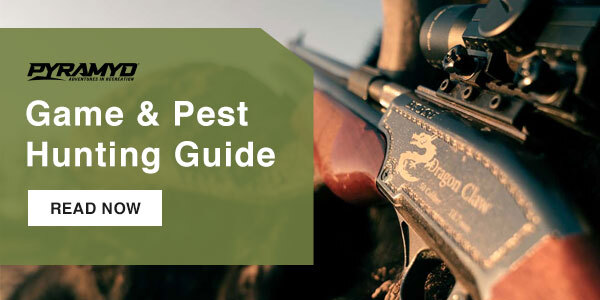
Good morning all, late night working tonight, and I thought I would take a break…and read my favorite blog.
I have found that if I take a ball of duct seal (impact putty) about 1 inch in diameter and smash it into a flat pancake about 1/8 inch thick or so, and then stick that between the target paper and the cardboard backer, then even domed pellets will leave crisp holes like the bullets do from centerfire cartridges. It sticks just enough to the back of the target paper to hold it together until the edges of the pellet pass through. Then you can ball up the leftover duct seal and make another pancake for the next target.
If I finish this job I’m working on, I’ll demonstrate later on with a few pictures.
And since I started using rubber mulch pellet traps, I have an extra ten pounds of duct seal laying around. :o)
Here are some pics of what I described above. Note the difference in the holes made without the duct seal layer and with. These were made with Crosman Essential .22 Domed Pellets, 13.7 gr., out of my new Crosman 362 with 7 pumps.
Roamin Greco – I also tried it! 🙂 How funny that people come to exactly same idea.
They say: “Great minds think alike.”
Roamin Greco,
FULLY agree! 😀
Roamin,
Those are some impressively clean holes for domed .22 pellets! I will have to try that after the weather warms just a little more.
Good tip.
Michael
Glad I could share. Enjoy.
BB,
My brother and I draw targets on white laminate particle board such as one might find in cheap shelving. Even domed pellets cut crisp holes that are easy to measure if we take care to discount any slight chipping. Often, when we double-check each other’s groups, our measurements disagree by a mere 0.001 – 0.002″.
Daniel
I’ll bet the pellet strike is louder than the gun’s report. If so, not basement friendly.
Daniel,
That’s an idea I haven’t tried yet. Thanks,
BB
Daniel,
I also tried it and it works fine. It is too loud for me in the basement – and it takes too much time to just quick change the target. It is definately good for long range shooting.
BB,
Not only do your coins give an easy mental image of how big or small the group sizes are but it also decreases the mental effort to translate the picture written in words. I find it difficult to picture in my head that 0.005 inch that you speak of but the micrometer opened to that size with a coin in comparison make it easy (I’m a native metric reader I don’t usually deal with sizes smaller than an ⅛ of an inch).
Siraniko
PS Section Data mining 1st paragraph last sentence: “So, yes, this report was easy to write, but it still took a long time because I had to edit as I wen (went).”
Section How to measure group size 3rd paragraph last sentence: “It sounds easy and would be excerpt (except) for one thing.”
Siraniko,
I fixed them both. Thanks,
BB
BB-
Good read on the topic. I think B-I-L Bob has given you another blog topic- Accuracy versus Precision.
I’ll toss another couple of measurin’ kinks in to the mix.
1)- Use a plug in the holes to help you get the diameter. Drill rod or a drill bit shank is accurately ground to size and available in a wide range of sizes. A #16 is .1770 in. and will tend to self center in the hole. Carefully close the calipers against the rods. Requires a light touch.
2)- Plastic circle drawing templates. Recently bought a new set online. Two sheets with hole diameters 1/4” to 3”. Quick and easy to use. A rapid way to tell if one group is bigger/smaller than another group. If you need numbers, find the hole that encompasses the farthest two shots, measure hole and subtract pellet diameter. Adjust number- the templates have a lot of hole diameters, just not every hole diameter. I’ve worked with thousandths and tenths, as well as smidges and hairs, for over 50 years.. Have a pretty good feel for eyeballin’ You can too, just takes practice.
Good reminders.
The person that shoots to determine PRECISION never hits the bullseye.
This blog topic is a bit disappointing since they told me there wouldn’t be any math associated with my relaxation and distraction of shooting.
Math…you only use as much as you need. I like counting the pumps on my new 362. That’s really all the math that is NEEDed. If you WANT more math, there is always standard deviation. ;o)
” If you measure from the extreme edges of the two bullet (or pellet) holes farthest apart and subtract one bullet/pellet diameter from the answer…”
B.B.,
I have always done as you’ve outlined here…with the exception of using old non-dial calipers, and having to do some interpolation. Kelli is not too sure about that; she thinks I should have bought the ones with a dial…but the old machinist who advised otherwise had a good point: many people wherever I worked had their dial calipers “disappear,” but no one ever messed with mine. 🙂
This is a great report for those just getting into shooting.
Take care & God bless,
dave
Dave,
I use my sigital calipers more times a day than I care to count if I’m doing a lot of work on guitars. My problem with the old dial calipers was my difficulty reading them, which got worse as my eyes started to get weaker. I knew I had to bite the bullet and go with digital when one day a few years ago I reached for a magnifier to be able to read a dial.
Michael
Michael,
At the second company at which I worked, I was the only one with non-dial calipers; most people had dial calipers, but a few of the younger folk had digital calipers (which had just come out). One of them let me borrow a digital caliper to try it out, and yes, they are certainly very easy to read, and there is no way to make a mistake like with mine, where you could do a bad interpolation. 🙂
Blessings to you,
dave
BB, I have found that a steel plate painted white is a very good target. Ron Robinson has used a steel plate for years for internet post and in his books. Harry Fuller in Australia often did this as well for his post. My steel plate is about 1/4″ thick and about 18″ x 24″. When a pellet hits the target it almost always leaves a tiny dot of lead at the center of the pellet strike. The pellet strikes normally leave a very clean and easy to see defined group. Every once in awhile a fresh coat of paint and a bunch of dots with a black magic marker provides me with a fresh target.
I just saw that Jeff Cloud has announced the dates of the Texas Airgun Show on September 24th with a FT match the following day, the 25th. I have sent in an email to reserve a table. I will probably have some of those Snappy Target Measuring Gauges at the show.
David Enoch
David,
I have asked for three tables and I asked for them outside, so I don’t clutter up the inside. I plan to sell a bunch of collectible airgun at a loss, just to move them on.
BB
That’s a similar principle to bell target shooting, isn’t it?
http://www.belltarget.com/targets.php
Although presumably Webley & Scott’s guide to bell target shooting wouldn’t pass muster today – note the position of the scorer!
Iain
B.B.,
Very good report.
In every sport there is a quest for a metaphoric Holy Grail, or unicorn, the ultimate, definitive, objective method/tool for scoring. I vaguely recall reading (a long time ago) that scoring targets was one of the most difficult procedures in 10 Meter Olympic airgun, or something to that effect. I suppose that became even more the case when shooters and equipment advanced to the point that perfect scores became a possibility.
Michael
Michael,
Yes — scoring a match target is extremely difficult. All the talk about measuring to the thousandth of an inch goes away when a magnified plug can’t get closer than 5 thousandths. That’s why the sound transducers were introduced at the major matches.
BB
“That’s why the sound transducers were introduced at the major matches.”
B.B.,
I haven’t shot any kind of match in years. How do sound transducers help with scoring? Thank you.
Take care,
dave
Dave,
There is no real target. Instead a continuous roll of target paper rolls past an opening. When the pellet tears through the paper three microphones measure the time the sound takes to reach them. The difference in milliseconds locates where the pellet passes through the paper.
BB
B.B.,
Whoa! That by comparison makes the electrical-circuit-completion gizmo in fencing look like caveman technology.
Anyway, don’t wait to hear the starter pistol. Jump forward the moment you see the smoke. :^)
Michael
Wow! That’s awesome; thank you! 🙂
BB,
Good blog! Everyone who shoots will be doing some measuring 🙂
The Group Mate looks like a convenient tool. Like pacoinohio I use a drafting circle template to measure my groups and I am not overly concerned about precise numbers. To me, groups are for measuring consistently which has enough variables that +/- 1 mm is close enough – IMHO measurements less than that are just part of the background noise. I just use the numbers on template (ignoring “pencil allowances” inaccuracies) and don’t even bother subtracting the pellet diameter as I’m only looking at the relative size of that group to other groups.
To me, accuracy is all about hitting precisely where you want. Perfect groups (exactly stacked pellets) show incredible consistency but are absolutely useless unless you can’t hit where you want. In target shooting “close” is important for scoring, when hunting a miss by a millimeter is no different than a miss by a centimeter… no meat for the pot.
That being said, when practicing I measure the distance from the point of aim to the center of the point of impact and this number tells me how accurate I was.
I have a measuring tool similar to the Group Mate. It’s a 6 inch piece of clear plastic that I’ve scribed concentric circles (.177, .22 & .25 diameter) on to help me center the template on the pellet hole so I can easily measure the distance between the POA to the POI. The center of the circles has a small hole for my caliper to fit into so I only have to worry about aligning to the POA. Works for me 🙂
Cheers!
Hank
You could have punched some big, measurable holes with these but rehabbing them will take some doing.
http://www.thehistoryblog.com/archives/63674
I’ve been using RangeBuddy lately. It’s pretty much dead on, and makes it easy to save data.
Here is one of FM’s pellet group measuring tools – the Round Tooit SMMC – Starbucks Mermaid Measuring Cap; diameter approx. 1.5” and the holes show up well enough.
Go ahead and laugh at FM’s shooting skills…no one’s laughing harder than he is.
I like it! 🙂
FM,
As long as you are having fun!
Just like fishing eh? I always enjoy being out in the boat weather I catch a big one or not! 🙂
Hank
Hi BB,
While on the topic of group size, I have always wondered how you cam to the axiom, “….10-shot groups. They’ll always be 40% larger than 5-shot groups.” (/blog/2013/05/walthers-new-lgv-master-ultra-177-air-rifle-part-6/)
I believe I have read you saying this in other contexts, but if you have explained the origin of this estimate, I have missed it.
Just curious.
Thanks,
Airman
Airman,
Just my experience.
BB
B.B. and Readership!
Tom your 40% number based on experience is backed up by the math… hopefully no one is surprised!
A number of years ago a UK Shooter wrote this very simple approach to the problem:
“OUTLIERS IN GROUP TESTING: WHEN TO EXCLUDE FLYERS
by Joe Brennan
Sometimes during a test we get a group with one shot way out, an outlier.
Our choice is whether or not to INCLUDE that outlier group in our results/calculations.
Here’s a simple rule for 5 shot groups:
On the outlier target, measure the smallest 4 shot group and the 5 shot group including the outlier.
Divide the smaller into the larger.
If the answer is more than 1.7, DON’T INCLUDE the group.
If the answer is less than 1.7, INCLUDE the group.
Here’s an example: A set of 5 shot groups has one group with a very wide shot. The four shot group size is .8″. The five shot group size is 1.5″. Dividing .8″ into 1.5″ we get 1.875.
Since 1.875 is more than 1.7, DO NOT INCLUDE the group.
For 10 shot groups, measure the nine and ten shot group sizes, divide the smaller into the larger. If the result is more than 1.43, DO NOT INCLUDE; if less than 1.43, INCLUDE the group.
(Take note of that 1.43 decision point)
WHY?
A 5 shot group is 1.1 times the size of a 4 shot group.
A 10 shot group is 1.03 times the size of a 9 shot group.
The standard deviation of 5 shot groups is .269 X the average.
The standard deviation of 10 shot groups is .195 X the average.”
The math containment formulas are really complex compared to these simplified arithmetic processes.
I shot at the 100 indoor range today with my .22 SIG SSG ASP20. I only shot the 5.5 JSB EXACT JUMBO 15.98gr. today. The JSBs fit the bore well and seat flush with a simple but firm push of the thumb. I don’t think seating deeper into the bore has any effect on precision for my skill level (Rank Beginner) for now.
I started at 25yards sighted in and stepped it out in 25 yard increments to 100. By the time I was done I had put close (some few did go into the same hole) to 300 little holes into three NRA A17 targets shooting away 330 of the JSBs
I am almost broken in on break barrel springers; i don’t know about the ASP20.
At 100 yards I am still only flirting on either side of 2 MOA. The patterns are round and concentrated toward the center which is better than in my first few outings with the SIG. I probably need to use a better target than the NRA A17 which is actually an Official 50 Ft. Small Bore Rifle Target.
I believe in the hands of an expert break barrel shooter the .22 SIG should be close to an MOA shooter.
I have no idea if the JSB is THE PELLET but it is fun finding out one pellet at a time.
shootski
Mr. Airman, you may find this link interesting reading:
https://precisionrifleblog.com/2020/12/16/statistics-for-shooters-executive-summary/
Thank you. I will check it out.
This question is a couple days late and is prompted by the recent blogs on the multi-pump 362 and Dragonfly. I’ve only been shooting air rifles for about 18 months as my introduction to air guns was inheriting my father-in-laws Benjamin 132 air pistol about 4 years ago. I have since acquired a mix of mostly replica CO2 and SSP pistols and BB guns AND a Crosman 1077 as an introductory air rifle. Additionally, a friend graciously gave me a reliable Benjamin 312 shooter that has further peaked my interest in backyard air rifle plinking (less than 25 yards). Given the age of this Benjamin 312 and my unfamiliarity with its expected operational life, would it be better to treat it a bit more gently and rely on a newer multi-pump to satisfy the air rifle shooting itch and the accompanying GAS (Gun Acquisition Syndrome )? Retirement is approaching and increased trigger-time is definitely planned. Thanks for the collective knowledge shared here.
Remarq,
I don’t have a Benjamin 312, but I have a similar rifle, a Sheridan C-model from 1975, my first-ever air rifle. Yes, I ordered a Dragonfly Mark2, and yes, I will order a Crosman 362. The Dragonfly I hope to scope for longer distance shooting; and I want the 362 to leave out in the garage…a place I would not leave my Sheridan, since it’s my first airgun and I got it from my Dad. However, I still shoot my Sheridan, and she shoots just as well today as she did back when I first got her (although I did switch to modern JSB pellets). Your Benjamin should be just as tough a rifle as my Sheridan; I would like to get a 312 myself, as I think they are just really cool. If I were you, I would shoot that old gal a whole big bunch. And if she ever does fail to hold air, there are parts available to get her going again; or you could ship her off to Rick Willnecker. He has repaired my Sheridan, as well as a dozen other pump and CO2 guns…a great guy.
(his website is here: http://www.airgunshop.net/ )
I hope that helps.
Happy shooting to you,
dave
Thanks for the advisement. The 312 seems to have a good reputation in the online community. 5 pumps gets me between 495 and 556 fps depending on pellet, with a rested accuracy that challenges my shooting abilities. Again thanks.
Remarq,
The 312 is my favorite airgun, keep the pump piston and linkage well oiled and it will last generations. Like Dave said parts and service are still available if needed.
Don